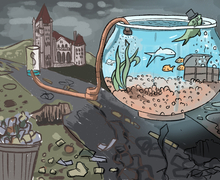SA advances menstrual product availability project into phase 2
Megan Thompson | Digital Design Director
The second phase of the Student Association’s plan to provide universal access to free menstrual products is experiencing delays, SA members said.
Get the latest Syracuse news delivered right to your inbox.
Subscribe to our newsletter here.
The second phase of the Student Association’s plan to provide universal access to free menstrual products is experiencing delays, SA members said.
Over the past five years, Syracuse University’s SA has taken on the task of providing universal access to free menstrual products. The second phase of the rollout, which was scheduled to begin this summer, has had slow progress due to asbestos in Falk College, Bird Library and the Hall of Languages as well as difficulty drilling into certain walls, Ginelli and SA President David Bruen said.
The second phase includes 11 buildings: Hinds Hall, Link Hall, Slocum Hall, Bowne Hall, the Physics Building, Huntington Beard Crouse Hall, Hall of Languages, Hendricks Chapel, Carnegie Library, the Newhouse School of Public Communications and the Whitman School of Management, Bruen said.
The first phase, which SA and SU has completed, prioritized campus hubs such as the Schine Student Center, the Barnes Center at the Arch and the Life Sciences Complex.
“Having a period is just another stressor,” said Anna Ginelli, SA’s speaker pro tempore. “It’s important we can (mitigate) stressors like that so students can enjoy their time here.”
Another issue SU and SA are having with the rollout is that there is no way to report if a machine is out of products, Ginelli said. At this time, janitorial staff refill the machines every other week, but SA hopes to upgrade to weekly refills, she added.
Installing the machines in phase one cost $29,925 and the menstrual products needed cost an additional $27,000. The total cost of phase two is $59,455.
Additionally, SA is addressing bathrooms for all genders with the initiative. While women’s and gender-neutral bathrooms were initially the priority, SA and SU are starting to provide menstrual products to men’s bathrooms as well.
“We understand not everyone (that menstruates) is using the female bathrooms,” Ginelli said.
Residence halls may also be included in future phases, Bruen said. When the project started, SA would provide small packages in residence hall bathrooms where possible. Now, packages of menstrual products may soon be provided to a “central point” in hall lobbies, Bruen said, as placing menstrual product machines in every dorm bathroom would be excessive.
Ginelli said dorms are places where many students spend their time, and expanding the project to dorms is consistent with SA’s goal of providing universal access to these products.
SA is also collaborating with Hendricks Chapel to provide menstrual products for its food pantry, which will give students who might need economic assistance an additional access point, Bruen said.
“Over the course of five years, (SA) went from installing little carriages in (dorm) bathrooms to working with the university to install dispensers in bathrooms,” Bruen said. “In the next five years, my hope is we’re really not … paying for this anymore. Not because we want it to end, but because the university (has) now taken it on.”
Published on September 12, 2022 at 12:22 am
Contact Kaitlin: kcampb14@syr.edu






